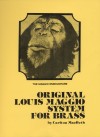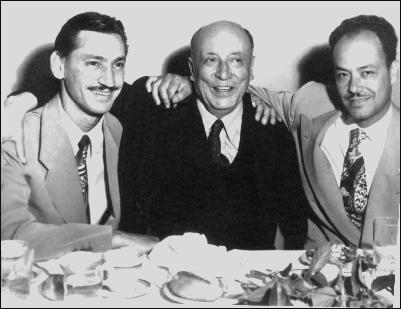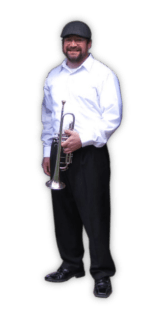 Louis Maggio’s master instructions were not the product of some brilliant musical super-brain, but instead a result of the consequent struggles related to a tragic accident that changed his entire life. Maggio, an Italian native pursuing his music career in the United States since 1906, was to appear with the Saint-Paul Symphony when sudden disaster struck in the winter of 1919. During subzero weather, while running to catch a streetcar, Maggio slipped on icy pavement and fell, striking his mouth on a safety zone button. The force of the blow literally shredded the artist’s lips and knocked out several front teeth.
Louis Maggio’s master instructions were not the product of some brilliant musical super-brain, but instead a result of the consequent struggles related to a tragic accident that changed his entire life. Maggio, an Italian native pursuing his music career in the United States since 1906, was to appear with the Saint-Paul Symphony when sudden disaster struck in the winter of 1919. During subzero weather, while running to catch a streetcar, Maggio slipped on icy pavement and fell, striking his mouth on a safety zone button. The force of the blow literally shredded the artist’s lips and knocked out several front teeth.
The medical community could not do anything for Louis Maggio. His music career was obviously finished. Although despondent, Maggio pursued the challenge and for the next year counseled himself, conceiving a totally new concept of brass playing.
To the amazement of his colleagues, the system Maggio had created not only enabled him to return to his chair with the symphony, but he was playing better than ever. He had acquired an unheard of five octave range and he displayed a rich velvet tone throughout all registers.
The news of the success of Louis Maggio spread gradually in the world of music. Brass players having similar problems started to seek his expert assistance. In 1930, Maggio settled in Los Angeles to devote himself to full-time teaching, and eventually to establish an international reputation as an acclaimed master brass instructor. He was able to help all those who came. His students played better than ever before; his success was so large that a majority of the West coast studio brass musicians became zealots of his method.
Louis Maggio has had a considerable influence on the training of many professional trumpet players in the United States.  In the photograph to the right, Louis Maggio (center) can be seen surrounded by two of his famous students: Phil Candreva (left) and Rafael Mendez (right).
In the photograph to the right, Louis Maggio (center) can be seen surrounded by two of his famous students: Phil Candreva (left) and Rafael Mendez (right).
The Maggio System reveals that a brass player’s throat should initially be open. For this, it is necessary to incline the head behind and look at the ceiling. This position forces the opening of the larynx. When tilting the head in position to play, preserve the open throat. It is an open throat, Maggio insists, that makes it possible to control the airstream while raising and lowering the tongue according to the pitch of the note. A brass player is able to avoid having to press on the lips allowing them to vibrate more freely and maintain their natural shape. Another characteristic of the Maggio method is to gather the lips around the mouth rather than to stretch them as in a smile. This concept is represented by the picture of a pursing monkey on the edition’s cover. This same picture hung in Maggio’s studio, a constant reminder to his students to be vigilant with their embouchure positioning. This method was formalized and published in 1968 by one of his students, Carlton MacBeth. ~Adapted by Scott Webber

I used the Maggio system in high school with good results. My hs band director, a brass player himself, introduced me to it. I can attest to its effectiveness. I had a good g above high c. We played pro-level charts, Kenton’s Little Minor Booze, and Here’s that Rainy Day, for example and our band from a small farm town in Wisconsin achieved statewide recognition. I later attended University, where my teacher took away my Maggio #2 mpc and “taught” me how to actually play the trumpet in a classic sense. I wish had the mouthpiece back, just for old times sake. But
Thanks so much for sharing! Your comments are greatly appreciated.
~SW
thanks for your advice. a question about Louis Maggio’s Italian origins. Do you know in which city he was born? Thanks again
Louis Maggio was born on 13 August 1909, in Hazleton, Luzerne, Pennsylvania, United States.
Thanks for your question!
~SW
I studied with L.M for a brief time, I don’t remember if I benefited from it…but he bought me a carton of cigarettes for my B day..he was a very sweet man. I went on to study with Irv Bush another wonderful man and teacher. Over 30 or so yrs I picked up bass,valve B, flugel,tenor S.soprano and flute. For me trpt. has been the most demanding. When I was working 7 nights, brunch on Sundays and a radio show on Tues. afternoons while working with Big Tiny Little (20 yrs) and working the Biltmore for 3 yrs and then the Scotsdale Hilton for a couple more….it seemed a little easier. Now days I pick up the trumpet just about every day….almost all the work is on tenor and flute…In those days I did a fair job on The Virgin of Macarena,(?),,not any more We saved our money, bought a home in las V met a lovely girl in PR while working the Princess C line, 38yrs of marriage…happy to be still honking a little I remember L. having a sawed of stem on a tbone mp with a wire soldered…to illustrate the “kiss” Thanks for your remarks
Hi Mr. Greene,
Thanks for the comments, I used to play on an Irving Bush mouthpiece. It was one of my favorites when I was in college as it had a nice smooth inner rim contour! That’s quite a career you’ve had, congrats for that and 38 yrs of marriage also! Many blessings to you and yours.
Regards,
~SW
Hi Scott.
Well, so far, the attention to ‘lips together’, the syllables and the ‘eye’ teeth (in relation to embouchure formation) are all paying dividends and have already subtly altered my playing in a very positive way. Onwards…. – will be interesting to see what develops if I can stick at it!
Best wishes,
Bob
Thanks so much for the update. Your comment was a great reminder for me about proper embouchure formation (the ‘eye teeth’)! I’m off now to practice some Cole Porter charts, thanks again for your insights and experience doing Maggio’s method on the horn! ~SW
Oops! Apologies for mis-spelling. 🙂
No worries, I was able to edit the typo out of your previous comment 🙂 ~SW
Hi Scott. I’m Principal Horn with Opera North in the UK. I’ve had the Maggio book for years for my own research and teaching but never been disciplined enough to do it thoroughly! Do you know of the experience of any horn players with the method? What tempo do you advise as a rule of thumb?
Mr. Ashworth!
Thrilled to have you stop by Tromba de Webber, Thanks for the question! I encourage my students to go pretty slowly through each, the advanced exercises have sixteenth note runs that can be fast even at a slower metronome marking such as 60 beats per min. The Maggio method tends to reveal the lack of efficiency we might be exhibiting in our playing. Being able to play the exercises at a slow and steady tempo with a full whole note at the end is achieved with both a larger more relaxed breath but also a slower more efficiently released air stream (max volume with min effort!).
I also think that focusing on a relaxed open throat position and control of the air stream over the arch of the tongue to be critical in the execution of this method.
I am aware of several horn players who have felt that they benefited from working through Maggio’s method and I’d be interested to hear what you have found works for your practicing.
Regards,
~SW
wonderful advices and information. Thank you very much
You are very welcome, thanks for stopping by! ~SW
Helpfull thanks
Thanks for stopping by, let me know if you need any help learning the Maggio System!
Hi, do you teach privately and how much?
I sure do, fill out this form to get a free lesson via Google Hangouts (requires webcam, Google account)
I live in Seoul and I’ve been striveing for maggio system for many years
but still not easy to understand
if u have any of recommandation
please give it to me
Many thanks
Jimmy cho
Mr. Cho!
Thanks for your inquiries regarding The Maggio Method. It is a helpful system as long as one recognizes that it is just one of many ways to assist trumpet players in expanding their range and flexibility with consistency of tone.
Here are some key points to getting this system working for your trumpet playing,
1. Having a relaxed and open throat is the key to Maggio’s philosophy of playing the trumpet. Forcing the throat open is no good (Forcing anything regarding trumpet playing is usually bad!) The correct sensation is most similar to the feeling achieved by mouth breathing through an empty paper towel roll. Try it! And as you progress through this experiment, notice how the relaxing of the jaw and a natural opening of the throat seem to be related.
2. Next, you must find open valve pedal “C”. (Concert “B-flat” on a B-flat Trumpet) Maggio constantly goes back to this as another method to relax the throat and provide low frequency vibrations for the chops (embouchure) in a musical manner.
My best advice is to try and make these exercises as musical as possible, thank about soft “lyrical” sound and airstream to match. I hope this is helpful information, all the best!
Scott Webber
(via email on 02/09/2016)